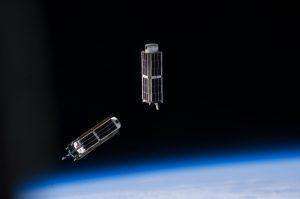Call Toll Free +1 855-856-TIPS
AUGUSTA, MAINE – NASA is currently funding a tiny satellite which is set to launch into space sometime in June. Although the definitive date remains undisclosed, the loaf of bread sized satellite is composed of four cameras to measure urban heat islands, identify algal blooms, and measure organism concentration in oceans. What is organism concentration? Organism concentration in oceans can be measured through the buildup of a chemical in or on an organism when the source of the chemical is primarily water; which, is referred to as bioconcentration. Bioconcentration is also described as the process by which a chemical concentration in an aquatic organisms exceeds that in water as a result of chemical exposure to water.


NASA’s National Space Grant College and Fellowship Program provides funding for the network (also known as Space Grant). Congress established Space Grant in 1988 to support the nation’s research and engineering sector. The Executive director of the Maine Space Grant Consortium (the NASA-funded nonprofit who is behind the initiative), is Terry Shehata. The NASA-funded organization is attempting to convince Maine lawmakers to amplify the state’s role in the advancement of low-orbit nano satellites referred to as CubeSats, which are used for university and state agency research. If the effort is successful, new launch sites will be constructed at the Loring Commerce Center in Aroostook County and in Brunswick Landing.

bluShift Aerospace, based in Brunswick, favorably launched a commercial rocket from Loring this January. The spaceport works to draw new revenue into the state as well as maintain a profitable technology workforce in Maine.
NASA has implemented a goal of establishing a spaceport in every state. So far, the Federal Aviation Agency has approved of 12 spaceport locations; none of which are in New England. The proposed spaceport in Nova Scotia will be the closest.
Sponsored by Senator Mattie Daughtry, SpacePort Maine is being proposed in a bipartisan bill which would forge a public-private partnership consisting of building launch sites, a data and analytics center, and an innovation hub. Shehata has noted in statements that Maine’s propinquity to polar orbits gives the state an advantage in comparison to the other planned spaceports throughout the U.S. Furthermore, Maine already has an impressive space industry comprised of 86 local companies.
Claims are that a spaceport in Maine would allow for more access to hands-on science education to both educators and students as well as fuel innovation from small bushiness normally not able to access these markets. The University of Maine alongside the University of Southern Maine worked to build the CubeSat based on proposals of students from Saco Middle School, Fryeburg Academy, and Falmouth High School.
The state of Maine is presently being faced with a depletion of the workforce and a large aging population. Formation of a spaceport would be a grand notable addition to the New England economy. It will require anchor tenants and strong support from all tiers of educational levels in order to enact a sustainable space workforce but momentum seems strong and accumulating.
Learn more about these great programs and resources found within the source links. They are invaluable to organizations, business and of course students and educational facilities.
The Maine Space Grant Consortium supports education and research programs for researchers
Most Useful Links:
Learn About All The Space Grant Network Programs







